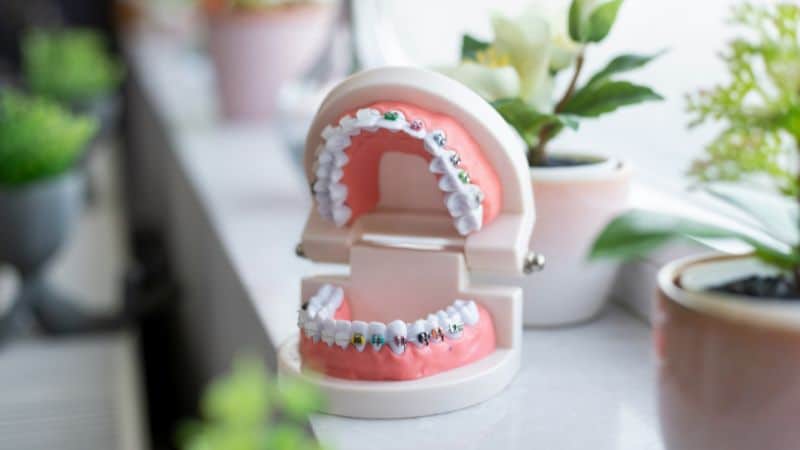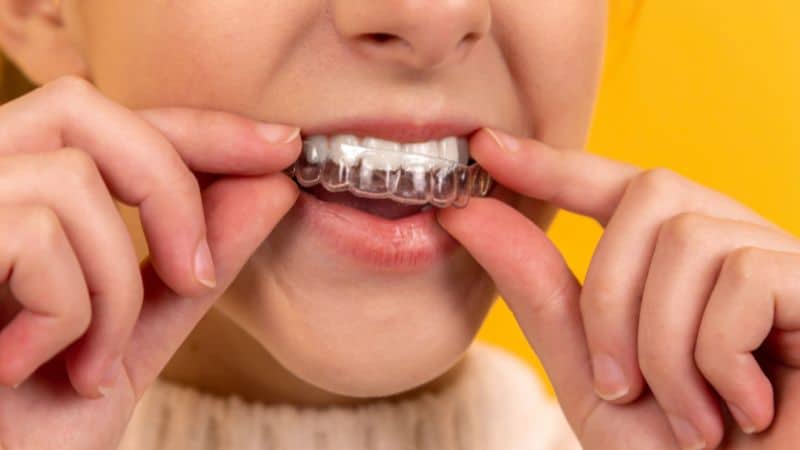
Invisalign vs Braces: 9 Comparison Factors
Looking to address misaligned teeth or bite issues? You’ll likely need to decide between two of the most popular orthodontic methods: Invisalign vs braces. While both orthodontic options aim to straighten teeth, close gaps, and enhance overall dental health, it’s important to understand the differences before you decide which option is best suited for you.
This article aims to explore and compare each option while highlighting their distinctions to assist you in making a well-informed decision.
Key Takeaways
- Invisalign is discreet and removable, while braces are more noticeable and fixed.
- Invisalign uses clear aligners you can take out for eating and cleaning, while braces use brackets and wires that are cemented to your teeth.
- Invisalign is better for mild to moderate cases, while braces can handle complex misalignment.
- Invisalign treatment may be faster than braces for minor cases, but both options require regular appointments.
- Both Invisalign and braces require good oral hygiene and have food restrictions.
- Are Invisalign and Braces The Same Thing?
- Working Principles of Invisalign vs Braces
- What Treatment Plan Will Work Best for You – Invisalign or Braces?
- Which Option is Aesthetically More Appealing and Comfortable?
- Treatment Timeline and Effectiveness
- What Should You Expect During Your Treatment Procedure?
- Cleaning, Maintenance and Dental Hygiene
- Food Restrictions
- What is More Affordable – Invisalign or Braces?
- Can You Switch from Braces to Invisalign Mid-treatment?
- Weighing Your Options – Invisalign® versus Braces
1. Are Invisalign and Braces The Same Thing?
While Invisalign and braces both fall under orthodontics as treatment options to align teeth and improve dental health, their methods and features differ significantly.
Invisalign involves the use of clear, removable trays (aligners) made from a patented material called SmartTrack. These aligners help to gradually straighten teeth while offering excellent fit and comfort and being easy to insert and remove. They are custom-made, virtually invisible, and particularly effective in treating mild to moderate alignment problems.
On the other hand, braces consist of brackets, elastic bands, and wires, available in materials like metal, plastic, ceramic, or a combination. Normally visible, they can be softened by opting for transparent or tooth-colored ceramic braces and wires in different, less visible shades, such as white. Regular orthodontist appointments are essential for adjustments, making braces suitable even for severe misalignments.
2. Working Principles of Invisalign vs Braces
Invisalign treatments and traditional braces work similarly: they exert pressure on the teeth to align them correctly. Both treatments begin with an assessment of your dental condition to determine the best treatment for you. Now, how do they work more specifically?
Invisalign aligners are custom-designed using 3D imaging to fit your teeth precisely as your treatment progresses. Each set of aligners is worn for a specific duration, typically 2-3 weeks. During this period, it exerts gentle, controlled pressure to move your teeth into alignment. Periodic check-ups with your dentist ensure the treatment progresses as planned, and adjustments are made if necessary.
Braces require the installation of brackets, small devices attached to the front of each tooth with dental adhesive to act as anchors for the braces. An archwire is threaded through these brackets, applying gentle but constant pressure to guide the teeth into their correct position. In some cases, elastic bands can be used to increase this pressure or adjust the occlusion. Regular adjustments are necessary to tighten the appliance and maintain progress.
3. What Treatment Plan Will Work Best for You – Invisalign or Braces?
Invisalign aligners are often preferred by those who want a more discrete option than braces. These aligners can be removed before eating or to clean your teeth, making them a convenient choice.
Invisalign aligners can treat a variety of orthodontic conditions, including:
- Mild to moderate teeth crowding
- Gaps between teeth
- Mild to moderate overbite, underbite, and crossbite
- Teeth misalignment or irregularities
Braces are recommended for individuals facing more complex orthodontic issues that require precise tooth movement and control. They are also a preferred option for severe misalignment and bite problems.
Braces can address a variety of orthodontic conditions including:
- Severe teeth crowding or spacing issues
- Complex bite issues including overbite, underbite, and crossbite
- Jaw alignment issues
- Teeth misalignment or irregularities of varying severity
4. Which Option is Aesthetically More Appealing and Comfortable?
Invisalign aligners are often considered more comfortable than braces due to their smooth, removable design, which minimizes irritation and allows for easier eating and teeth cleaning. They also offer a clear aesthetic advantage, being virtually invisible when worn.
Braces may initially cause discomfort and are more noticeable, but they provide customization options and are suitable for various orthodontic issues. Ultimately, comfort preferences and treatment needs vary among individuals.
5. Treatment Timeline and Effectiveness
Which method is faster: braces or Invisalign?
The duration for Invisalign orthodontic treatment varies depending on the individual’s specific dental needs.
Invisalign® treatments are known to be faster than traditional braces, especially for minor or less complex adjustments. Minor Invisalign treatments can take as little as 3 months. However, the average duration time for more complex treatments is between 12 to 18 months.
Braces can address complex issues related to orthodontics and use a traditional approach that gradually aligns teeth to the right position with the help of brackets and wires. This can lead to a longer treatment duration than Invisalign®, depending on the severity of the case. The average duration for wearing braces is between one to two years.
Is Invisalign better than braces?
While both orthodontic treatments aim to enhance your smile, their suitability varies based on your dental condition.
Invisalign is often recommended for mild to moderate issues, whereas bracesare preferredfor addressing severe bite problems and misalignments. The treatment duration varies depending on your dental needs. It’s essential to consult with your dentist to evaluate your teeth and agree on treatment goals. Additionally, you need to consider your lifestyle and budget whenmaking your decision.
6. What Should You Expect During Your Treatment Procedure?
During the Initial Consultation process, your orthodontist will evaluate your teeth visually as well as with X-rays, assess your overall oral health, and discuss your treatment options with you. At that point, you’ll be able to better assess your options and decide whether you’d like to continue with Invisalign orthodontic treatment, whether Invisalign or braces.
Invisalign Process
- 3D scanning: During the Invisalign process, 3D scans and impressions of your current teeth are taken. A custom treatment plan is made where the orthodontist maps the gradual movement of your teeth. At this stage, you may get a glimpse of how your teeth will look post-treatment.
- Fitting your 1st set of Invisalign aligners – New aligners are custom-made based on digital scans and fitted on your teeth. The orthodontist checks whether they fit correctly and are comfortable for you to wear.
- Scheduling appointments for aligners and check-ups: At this stage, the dental clinic will schedule your routine visits for receiving new aligners as well as for monitoring the treatment progress. You will need to typically wear aligners for 20 to 22 hours every day, for 1 to 2 weeks before switching to the next set. The dental visits required are relatively much fewer than for those with braces.
- Process completion: Once your treatment is complete, you may be provided with a retainer to maintain the results.
Braces Process
- Customization of braces: An accurate mold is taken with the impression of your teeth and braces are made depending on the type you choose.
- Installation: During this appointment, braces (including brackets, elastic, and wires) are installed in your teeth with the help of a dental adhesive.
- Scheduling appointments for adjustments and check-ups: Regular appointmentswill be scheduledfor adjustments, where the orthodontist will tighten or replace wires, adjust brackets to facilitate tooth movement, as well as monitor progress.
- Process completion: Once braces are removed, a retainer is provided for keeping the alignment in place.
7. Cleaning, Maintenance and Dental Hygiene
Whatever your dental condition and treatment, it’s extremely important to take care of your braces and maintain good oral hygiene.
To ensure treatment effectiveness, Invisalign aligners must be cleaned and maintained correctly. They can be cleaned with Invisalign cleaning crystals or other methods, including vinegar and hydrogen peroxide mixtures. Always rinse and dry the aligners before reinserting them in your mouth. Brushing and flossing after every meal are also essential to prevent cavities under the aligners.
Like Invisalign aligners, braces must be properly cleaned and maintained. Orthodontic toothbrushes and interdental brushes are needed to remove food particles and plaque. Although flossing can be performed with braces, the best solution is to purchase a water flosser such as Waterpik to ensure that all spaces between teeth are reached and properly cleaned.
8. Food Restrictions
Technically, Invisalign aligners have no dietary restrictions since you can remove them to eat. However, certain precautions must be taken. For example, it is advisable to remove them when drinking anything other than water to avoid staining or damaging them. Extremely hot, cold, sticky, and crunchy foods should be avoided, as they can cause discomfort or damage.
When it comes to braces, it’s necessary to make a few dietary adjustments to protect the rings and wires. It’s best to avoid foods that are hard, sticky, crunchy or difficult to chew, as well as soft drinks, natural fruit juices, energy drinks or sports drinks. Foods like nuts, popcorn and hard candies should be avoided, while softer foods like yogurt, pasta and cooked vegetables are safer choices.
9. What is More Affordable – Invisalign or Braces?
Though the costs of both Invisalign and braces are comparable, factors such as the complexity of the orthodontic issues and the length of the treatment required influence the final cost. Invisalign aligners may be slightly more expensive than traditional metallic braces. However, you need to consider the long-term costs and factors such as maintenance appointments and any additional visits that may be required. Finally, you will have to see if your insurance plan covers any portion of the orthodontic treatment you choose.
Can You Switch from Braces to Invisalign Mid-treatment?
There may be several reasons why braces aren’t quite hitting the mark for you. These could range from concerns about how they look or feel, dietary limitations, oral health issues, or simply not aligning with your lifestyle. If you find that braces aren’t meeting your needs, you have an alternative route available: a “mid-treatment correction” by transitioning to Invisalign. However, before making the switch, it’s crucial to undergo an evaluation by your orthodontist to ensure that Invisalign is a suitable option for your dental alignment needs.
Weighing Your Options – Invisalign® versus Braces
When considering orthodontic treatment options like Invisalign® or braces, it’s important not to make a hasty decision. Carefully evaluate factors such as your treatment goals, comfort, aesthetic preferences, treatment duration, maintenance requirements, as well as affordability. It is also essential to consult with your orthodontist to determine the most suitable treatment for your individual needs. Ultimately, whether you choose Invisalign® or braces, the aim remains the same: achieving a healthier, more confident smile.
Fortunately, orthodontic treatments have evolved to adapt to patients’ diverse dental conditions. Center Dentaire Pierrefonds is pleased to offer Invisalign® treatment to our qualifying patients. Contact us to get all the answers to your questions and book a consultation with one of our reputable dentists.




